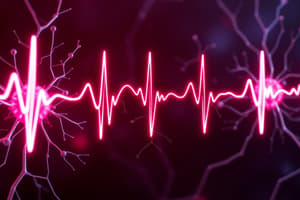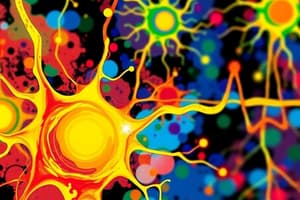Podcast
Questions and Answers
What are the two physical forces that make neurons more negatively charged inside than outside?
What are the two physical forces that make neurons more negatively charged inside than outside?
Diffusion and electrostatic pressure
What is the typical resting potential of a neuron?
What is the typical resting potential of a neuron?
- -100 to -120 millivolts (mV)
- -50 to -80 millivolts (mV) (correct)
- -10 to -30 millivolts (mV)
- 0 millivolts (mV)
Anions are positively charged particles.
Anions are positively charged particles.
False (B)
What are ion channels?
What are ion channels?
The sodium-potassium pump moves three sodium ions (Na+) out for every __________ potassium ions (K+) pumped in.
The sodium-potassium pump moves three sodium ions (Na+) out for every __________ potassium ions (K+) pumped in.
What does the equilibrium potential correspond to?
What does the equilibrium potential correspond to?
Flashcards are hidden until you start studying
Study Notes
Electrical Signals and Neuron Function
- Neurophysiology examines life processes of neurons, emphasizing their function and behavior.
- A resting neuron maintains a polarized state due to the difference in electrical charge inside compared to the outside.
Key Ion Characteristics
- Ions are charged molecules categorized as anions (negatively charged) and cations (positively charged).
- Ions exist in both intracellular and extracellular fluids, influencing neural function.
Resting Potential
- A microelectrode measurement in a resting neuron reveals an interior negative charge of –50 to –80 millivolts (mV).
- The negative value indicates that the neuron's inside is more negatively charged than the outside.
Ion Channels and Permeability
- Ion channels are membrane proteins facilitating ion passage; they can be gated (open/close in response to signals) or always open.
- Neurons exhibit selective permeability, primarily allowing potassium ions (K+) to cross while restricting sodium ions (Na+).
Forces Driving Ion Movement
- Ionic movement is influenced by diffusion (spreading towards uniform concentration) and electrostatic pressure (flow towards opposite charges).
Sodium-Potassium Pump Mechanism
- Neurons utilize energy to operate sodium-potassium pumps, expelling three Na+ ions while importing two K+ ions.
- K+ ions accumulate within the cell and can diffuse back out, creating an internal negative charge, which exerts electrostatic pressure drawing K+ ions back in.
Equilibrium Potential
- The equilibrium potential is the electrical charge that balances concentration gradient and electrostatic pressure, corresponding to the resting potential of the neuron.
Studying That Suits You
Use AI to generate personalized quizzes and flashcards to suit your learning preferences.




